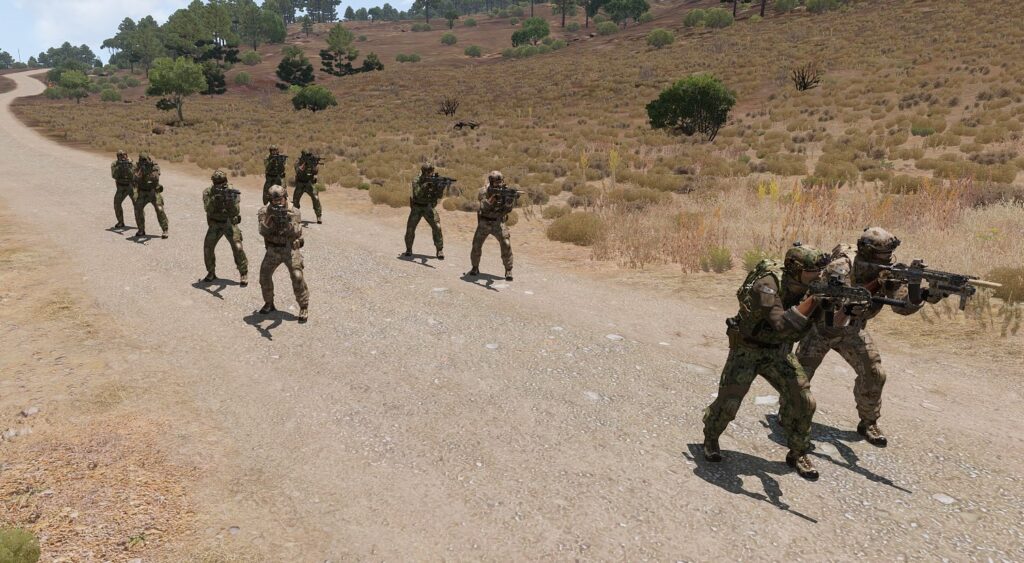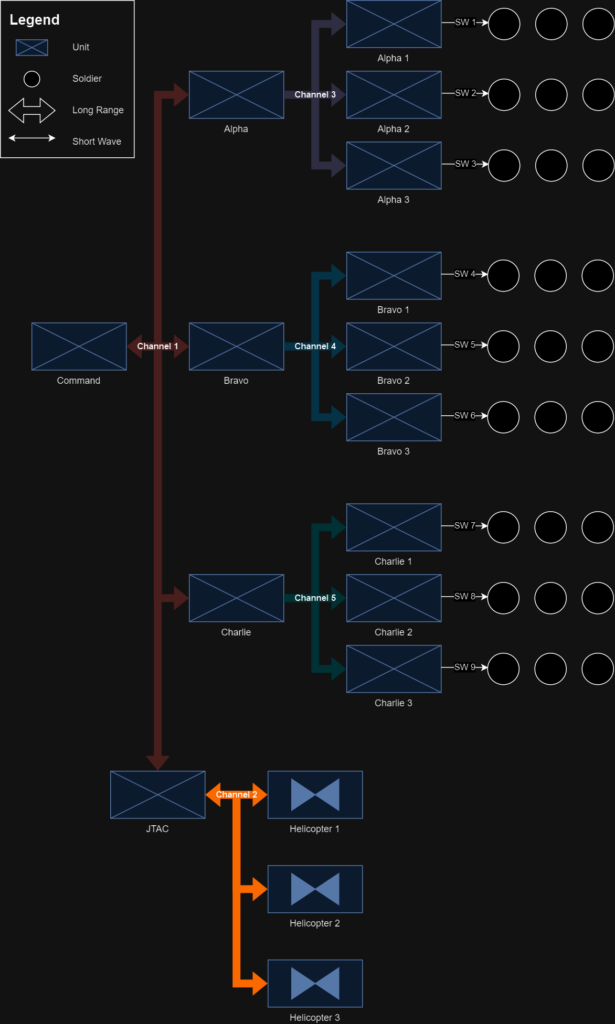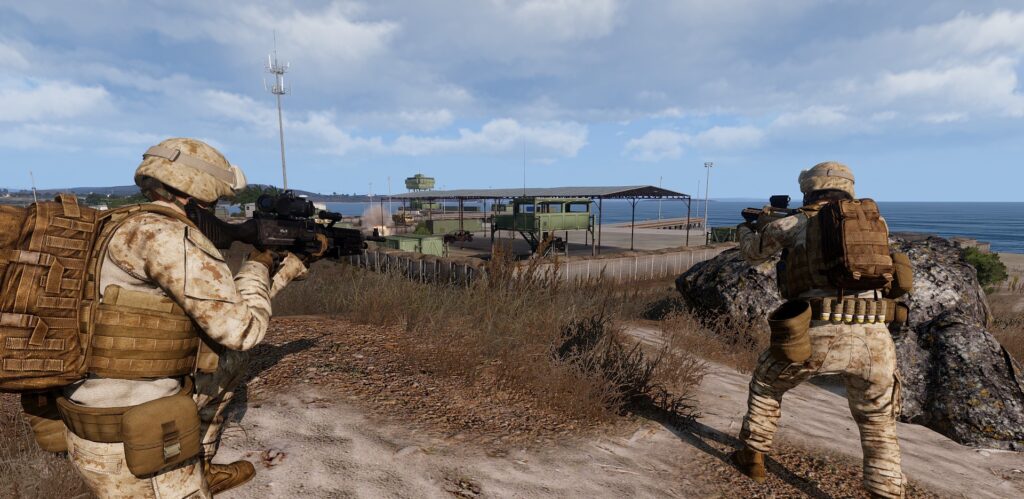How to be a Good Leader in Arma
A Guide from and for the Newfound Pioneer Corps
Introduction
So you decided to pick up a leadership role but you don’t have a lot of experience with it or never did it before. Or maybe you just want to improve your leadership skills, which is awesome! This guide aims to help with all of that. But if you are curious about something not included, or want to talk about something more in depth, then our community has many great, experienced leaders that will gladly help if you reach out on our discord.
A well organized, cohesive unit can tackle even the most difficult objectives and get the job done with minimal casualties. Here’s a few important points to make sure you become the leader who can make a squad work exactly like that. But before that, what’s your job as a leader in general?

Leadership in Essence
As a leader, you are concerned with three things:
- Execute the orders given to you by the chain of command or mission objective
- Give people below you in the chain of command orders
- Make sure everybody below you has as much fun as possible
Even if you don’t follow the following guidelines perfectly, just hanging onto these three points and making sure they are implemented into your leadership well is already great.
Rule of Three
Having to lead and coordinate other players can seem a bit daunting at first. But there’s ways to tackle this and make it easier for yourself. The rule of three is a simple and effective concept: Nobody should lead more than three elements. A platoon should have no more than three squads. Tank platoon should have no more than three tanks below the command tank. A company shouldn’t run more than three platoons. In a squad, you will usually have two fire teams and form up a third team with any specialists like an attached medic or engineer. Each fire team should consist of four people, so the fire team leader (FTL) also only has three elements (soldiers) below him.
This makes coordination much easier. The CO orders three squads around. The squad leaders relay them to their fire team leaders and they communicate these orders to their fire team. Much easier than you alone trying to coordinate 9 players.
Buddy System
It’s always a good idea for everyone to grab a “buddy” and stick with them. So as a squad leader you and your squad’s medic may form buddy team. Your first fire team leader can form a buddy team with the rifleman. And the machine gunner can form a buddy team with the assistant machine gunner. Same goes for the second fire team. The picture below shows your squad with soldier forming buddy teams.

Everybody has to work together with their buddy, look after them and call out if they are in trouble. As a part of buddy team, it’s your responsibility to look after yourself and your buddy at all times and work together as a team. Soldiers should always know where their buddy and what his status is.
Other players will usually know or quickly understand how buddy system works. But you as a leader should always make sure to let them know at the start of the mission that you want them to form buddy teams.
Radio Communications
Now all players are formed up in buddy teams, fire teams, squads, platoons and support units. In order for all of them to work together to achieve the mission objective, a great deal of communication is needed. In order to make this communication succeed, all elements are organized in different nets on the long range and shortwave radios.
Usually a command net or platoon net forms the main radio net. The CO and all squad leaders plus any support elements like aircraft or artillery are on it. Squads have a squad net, consisting of the squad leader and all fire team leaders. Each fire team usually has their own net of short range radios, if radios on rifleman level are used in the particular mission. While you don’t have to worry about using your radio too much as a fellow soldier, as a leader you need to make sure to use your radio properly and effectively without disrupting the communication between elements.
Radio Etiquette
- Keep the chatter to a minimum. Think twice about what needs to be said on the command net. If you’re saying something important, use as few words as possible. More words leave more room for misinterpretation and less time for important messages to be transmitted over the net.
- Do not let go of the button until your message is complete. Releasing the button will play a sound, letting your recipient know that they are clear to respond now, or freeing up the net for any further communication. If you continue after releasing now, chances are you speak at the same time with somebody else. If you really have to let go of the button in the middle of a transmission, say “Break” before you do. This will let others know that your transmission is not finished yet and will continue shortly.
- Alert, identify, confirm. Alert the person you will be talking to and identify yourself. So let’s say you want to say something to command. “Command, this is Alpha…” Wait for your recipient to accept your message if possible (By saying “This is command, send it”, or “This is command” or even only “Command”. Only then you should send your message. If they deny your message, usually by saying “This is Command, wait one.”, wait until they let you know that they are ready.
- When receiving an order, always acknowledge it, for example by stating your call sign and a copy, as in “Bravo copies”. If the order was complex, you can repeat it to make sure everything has been understood correctly, like this: “Flank left around the Southern compound and take an overwatch position on the ridgeline behind it, Alpha copies.”
- If you did not understand a message intended for you, say “Say again.” and wait for another transmission. You could also say “Repeat last.”, but if you want to keep it as MILSIM as possible you want to avoid saying that, as it is actually a request to repeat the last fire mission, usually to an artillery unit and sometimes fatal if mistaken.
- Do not cut into an active conversation. If a unit was asked a question, wait ample time for it to respond. If a command to a unit was issued, wait until it is acknowledged. Only cut in if it’s an emergency (by saying “break-break-break”) and even then you should at least wait until nobody is actively talking, because of the next point.
- All our radios are half-duplex. This means that they cannot transmit and receive at the same time. If a person is currently talking, they will not be able to receive any new message. Try your best not to talk at the same time as others.
- To avoid multiple people talking at the same time, do not inquire about multiple teams at the same time on the radio. Instead of saying “Alpha and Bravo, give SITREP”, say “Alpha, SITREP”, then wait for a response, and only then ask Bravo for their SITREP. If multiple squads have to acknowledge, they should follow squad hierarchy (Alpha first, then Bravo, etc.). When in doubt, follow the order of the slotting page.
Radio Structure
The below image is an example of a radio structure for an infantry platoon with an attached JTAC and three helicopters. All squads and the aircraft have their own channels to communicate, and one person of each squad plus the JTAC for the helicopters are in contact over the command net on channel one. In the field, helicopter pilots will usually use a second radio to listen into the command net so they know what is going on. Do you see how the rule of three is employed here?

Soldiers with Clear Orders/Objectives are Happy Soldiers
Simply always provide objectives and clear orders to your soldiers. If your squad runs into an enemy ambush, for example, the worst mistake you can do is not giving any orders. Any plan is better than no plan, so come up with something and have the others execute it.
When giving orders, make sure you don’t just convey what to do, but also why we do it. As a squad leader you may get the order to find a position to cover another squad. Don’t just tell your fire team leaders to walk up that hill. Tell them that you intend to find an overwatch position to cover the friendlies from. Everybody will have more fun in the mission when they have a sense of agency and feel like theiy contribute. Just being sent around aimlessly without a clue what other elements are doing can be quite boring and frustrating for players. Even experienced leaders forget about this sometimes.
Avoid Micromanaging if Possible
Always give your soldiers some freedom in choosing how they tackle the objective you just gave them. If you want a fire team to clear a small compound you just found, you should trust your FTL and soldiers that they will pick and employ a proper strategy to finish this task. Another good example is a platoon commander giving the squad leader an order to approach and engage an enemy position. A good commander will give you as much freedom as possible in handling this task. No matter which leadership role you pick up, make sure you trust the people in the chain below you to get the job done.
Also, make sure not to infringe on the other leadership roles below you. As a squad leader, you should not worry about the position of the machine gun in fire team 1, let the FTL handle that. As a CO, don’t order your squads into specific positions on the map. Give overarching objectives and trust your SL to pick an appropriate approach.
Use all the Assets Available to You
At each level of leadership, think about the assets available to you and make sure you employ all of them as much as possible. Not only is not using an asset for an appropriate situation a waste, but it’s also less fun for the players that control that asset. Your biggest mission is to make sure everybody has fun, so try to make use of everything at your disposal.
As an FTL, position your automatic rifleman in an advantageous position and tell him to suppress the enemy or tell your grenadier to launch some grenades over the compound wall you are approaching. As an SL, make sure your teams support each other and move in tandem. If you have attached specialists, find something to do for them. Have your medic conduct triage on wounded squad members themselves. Have your engineer place mines on exposed flanks or watch out for any enemy explosives. As a CO, use your CAS and artillery extensively. Keep your logistics busy by ordering resupply to specific points you coordinate with your squad leaders. Use all available transport and use it often. Let squads work together, don’t split them up across the map. Use vehicles in tandem with infantry for some great combined arms experience.
Available assets are an intended tool chosen by the mission designer to get your job done. Not using them may be dangerous to the success of the mission, but more importantly, it may mean that a player is bored. Never let this happen!

With that out of the way, you’re almost ready to lead your soldiers on the fields of battle! But before you do that, here are a few general tips that can make your job easier.
- Don’t move your teams too far from each other. Make sure they are always ready to work together and support each other.
- Fire without maneuver is indecisive. Maneuver without fire is fatal. Keep your teams firing and keep your teams moving.
- Actively evaluate your current situation and react accordingly. Or in general, just be aware of what’s going on the battlefield at all times. Did another squad retreat and now your left flank is exposed? Set up a security on that flank if possible. Be aware of what’s happening and how the situation is developing.
- Give out orders by name. This helps avoid a lot of confusion. “Hamster, pick up that rocket launcher” will make him do it, just saying “somebody should pick up that launcher” will probably not be executed, especially if bullets are flying.
- Not every shot is worth taking. Let your squad know when you want them to engage the enemy. Sometimes if not spotted, it’s better to close some distance first before engaging the enemy.
- Praise your soldiers! “Good shooting ” is always nice to hear after you effectively drop an enemy squad. In the end we are all here to have fun but the situations can get a bit stressful. Your job as a leader is to help with this too. A few nice words go a long way.
- Don’t stress too much if your order under pressure ends up making the situation worse. That’s how you learn and most importantly you managed to give out orders under pressure! That’s one of the most important qualities of a good leader.
- Prioritize fun! Maybe the tactical approach would be to move around the enemy presence between you and your objective, but it would probably be more fun to engage them and fight your way through.
- Take a breather! Sometimes stuff seems overwhelming. You gotta make decisions, keep people supplied with orders and keep track of all the elements on the map. Sometimes it feels like you have no time at all, but most of the time you can afford to step back a little and take a break to think things through. Sometimes you can’t afford not to do that, frankly.
- Learn from other leaders. If you’re just about to get into leadership, slotting up as a rifleman in a squad with an experienced leader may net you valuable tips and examples you can employ in your own leadership.
Above all else, remember not to put too much pressure on yourself when you’re learning to be a good leader. It takes time and practice to become a good leader. Reading this guide is already a great step one on your learning journey. Attend events with us when you can, take leadership positions and/or watch experienced leaders do their job and you will be a great leader in no time!